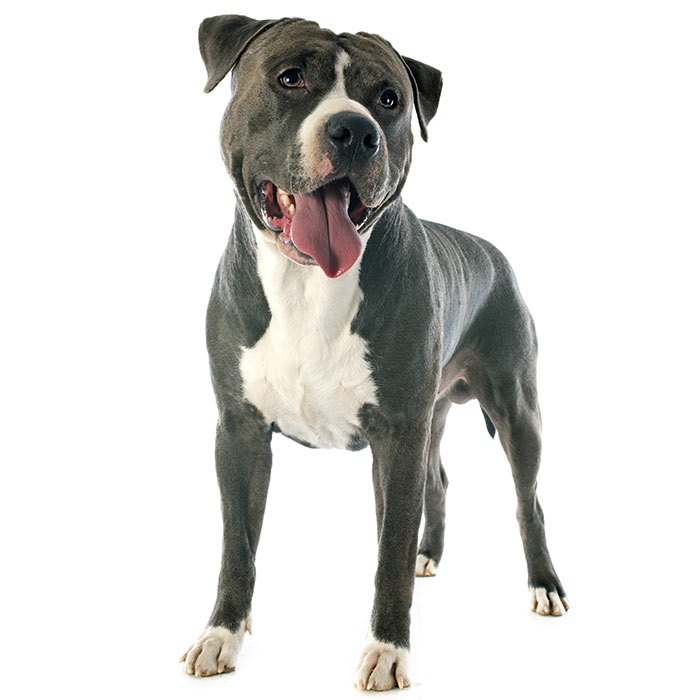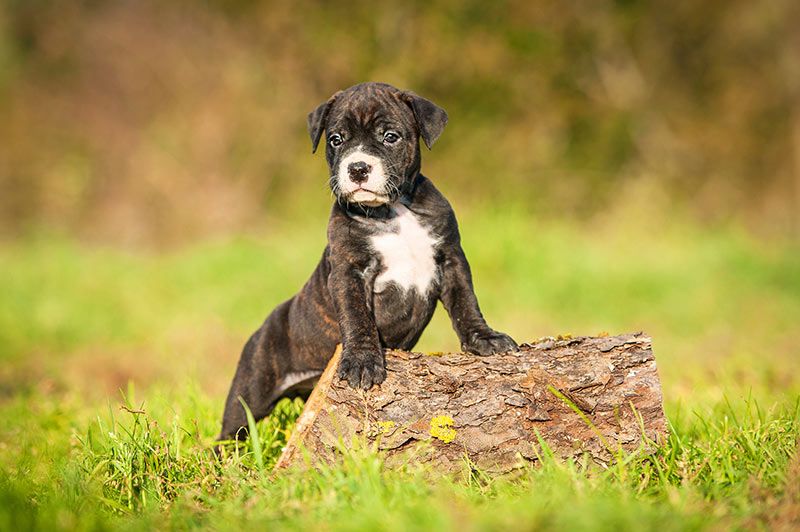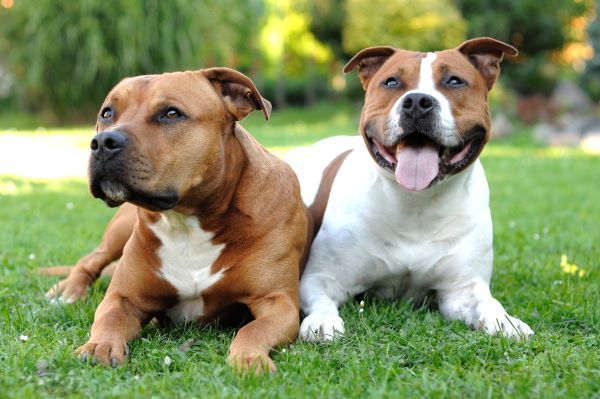American Staffordshire Terrier


| Recommended for | Families |
| Breed Classification | Terrier |
| Other names | American Staffy, Amstaff |
| Lifespan | 10-12 years |
| Size | Medium |
| Temperament | Loyal, courageous, friendly |
| Intelligence | Above average |
| Tendency to bark | Moderate |
| Maintenance Level | Medium |
| Health Risk | This breed has an around average probability of having health issues in its lifetime, hence it is one of the more affordable breeds to insure. |
Insuring an American Staffordshire Terrier?
Get our award-winning Nose-to-Tail Cover with up to $30k annual benefit limit, up to 90% of eligible vet bills back, and no sub-limits.
Get a quick quote
Is this breed right for you?
Try our breed selector quiz to find out your best matching breed!
Insuring an American Staffordshire Terrier?
Get our award-winning Nose-to-Tail Cover with up to $30k annual benefit limit, up to 90% of eligible vet bills back, and no sub-limits.
Get a quick quote
Breed history of American Staffordshire Terriers
The American Staffordshire Terrier was first developed in Birmingham, England from crossing the English Bulldog and a number of older terrier breeds. The purpose was to produce an animal with a great deal of strength, courage and tenacity. Further developed in Staffordshire, the breed finally reached the United States in the 1870’s, where it quickly became popular with pioneering families for protection, companionship and catching hogs and cattle.
After its introduction to the USA, it was bred primarily as a companion dog that could be used for hunting, protection and sport. The American version developed into a more heavy-set and muscular animal, eventually dwarfing its English cousin. Blood sport was a common use for the breed and Amstaffs were popularly chosen for use as fighting dogs until the sport was banned at the turn of the century. They are closely related to the American Pit Bull Terrier, from whom they were bred apart in the 1960’s.
From 1900 the Amstaff was developed to better suit a family environment and it was highly sought after by those wanting a dog with courage and tenacity to guard loved ones and property. The breed’s aggressiveness has largely been removed and the American Staffy has since proven to be a loving and gentle companion.
The breed came to Australia in 1985, was officially recognised in 1987 and the first Australian litter of American Staffy puppies was born in 1990. The first American Staffys to come to Australia were from the Hawaiian Islands.

Physical description of American Staffordshire Terriers
The American Staffordshire Terrier is a stocky, muscular medium-sized breed with a short body, deep chest and broad head. To some, American Staffys have an intimidating appearance, however its heavy-set and muscular build is the breed’s hallmark, giving the impression not only of great strength for its size but also of grace and agility.
The American Staffy coat is short, close and glossy. It comes in a wide variety of colours and patterns including black, brown, fawn, liver, red, white and the well known blue American Staffy.
| Weight range | 25 to 30 kgs |
| Height range | 43 to 48 cm |
| Colours | Black, blue, brown, white |
| Coat length | Short |

American Staffordshire Terrier personality and temperament
Despite its media reputation for ferociousness, the American Staffy is an affectionate dog with a sweet temper and kind and gentle nature. American breeders have worked tirelessly since the 1900’s to selectively out-breed aggressiveness, and although they are often still viewed with suspicion, they have become popular family pets.
Amstaffs are people-oriented dogs that thrive as part of the family. They are very clingy, affectionate and playful, and will show their owners tremendous loyalty – the most important thing in life to this breed is their owner’s fond attention. Very sociable dogs, they need good doses of human contact, and can suffer separation anxiety and behavioural problems if left alone for extended periods of time.
Stubborn, tenacious and fearless, the Amstaff makes an excellent guard dog. Typically docile and playful with its family, the American Staffy is generally friendly toward strangers as long as its owners are present. However, it will courageously protect its family and property if threatened, and its high pain tolerance and aggressiveness when provoked or cornered by an attacker will result in a determined and sustained attack.

American Staffordshire Terriers with kids and other pets
American Staffordshire Terriers are are generally good with children. Selective breeding has developed their temperament to be friendly, playful and patient, and their loyalty translates to a great deal of affection and gentle behaviour towards children within the family.
Although they are known to be good with children, they should still be supervised during play time. This especially applies to children and adults from outside of the family.
The American Staffordshire Terrier’s natural aggression is directed toward other dogs, especially those that challenge it. Introducing them to children, dogs and other animals as a puppy will help curb aggression and the earlier and more often the animal is socialised, the better.

American Staffordshire Terrier training and exercise
The American Staffy is highly energetic and enjoys regular exercise, so long daily walks, jogs or runs are essential to keep them happy and well behaved. Additionally, lengthy play sessions with their owner will promote physical and psychological health.
The breed generally enjoys any kind of dog sport. They show great talent as assistance dogs or even search-and-rescue dogs, where they can use their brain and muscle power. Many AmStaffs enjoy taking part in canine sports such as obedience, agility, and dock diving.
Being a strong, powerful breed, firm and consistent training is essential to ensure your American Staffy will obey your commands and behave respectably. Intense socialisation from an early age is also very important in order to curb potential aggression towards both humans and other dogs. Fortunately, Amstaffs are generally obedient and have a very strong desire to please their owner. Training should be patient, respectful, and firm. If not well trained, behavioural problems can develop and the Amstaff can become difficult to handle.
| Energy level | High |
| Exercise requirements | High |

American Staffordshire Terrier feeding and nutrition
The American Staffy should be fed a premium, high-quality dog food appropriate to the dog’s age (puppy, adult, or senior) and activity level.
American Staffys that aren’t sufficiently exercised may become overweight, so watch your dog’s calorie consumption and weight level and don’t overindulge in the treats department.
Check with your vet if you have any concerns about your American Staffy’s weight or diet.

American Staffordshire Terrier care and grooming
The AmStaff’s short, stiff coat is very easy to groom: simply brush it a couple of times a week with a soft bristle brush to remove dirt or foreign matter and to help manage shedding.
Although it only sheds a negligible amount, brushing is recommended for those who do not want to deal with dog hair in their cars and homes.
American Staffys are prone to skin irritations and should be regularly bathed.
Health issues for American Staffordshire Terriers
- Congenital Heart Disease is genetic and is the malformation of valves in the heart, causing serious problems that will often result in death within the first year of life. Those that have more mild forms of the condition will mostly survive but will show a tendency to avoid exercise, may have stunted growth or will occasionally faint. Cardiac arrest can occur at any time, but in most cases later in the Staffy’s life.
- Heart Murmurs, while not a disease, are common in the American Staffy and often reflective of congenital heart disease. A murmur is the sound the heart beat makes when an irregular amount of blood enters one of the heart’s chambers. Heart murmurs can be connected to endocardiosis, endocarditis, valvular stenosis or dysplasia. Many detected heart murmurs will not be severe or require any treatment.
- Skin Allergies are fairly common in American Staffys Learn more about allergies and other skin conditions.
- Hip Dysplasia is a hereditary condition and common in many breeds where the hip doesn’t develop as it should, often resulting in prolonged limping and eventually lameness in later life.
- Cataracts are an opacity of the lenses of the eyes that prevent light from reaching the retinas, leading to vision impairment and even blindness. American Staffys are prone to hereditary cataracts, which tend to form at a young age, typically between 1 to 5 years.
Not all conditions are covered by Pet Insurance. For details of Bow Wow Meow Pet Insurance cover, refer to the Product Disclosure Statement.
Thinking about insuring an American Staffordshire Terrier
Thinking about insuring an American Staffordshire Terrier
Learn moreThinking about insuring an American Staffordshire Terrier
Learn moreFree engraved pet ID tag on sign up3
Customer Satisfaction
21 day cooling off
Easy to use Pet Portal

GapOnly® in vet claims
MORE INFORMATION
Saving Staffies NSW: https://savingstaffies.org.au/
QLD Staffy & Amstaff Rescue: http://www.qldstaffyandamstaffrescue.org.au/
Stafford Rescue Victoria: http://staffordrescuevictoria.org.au/
American Staffordshire Terrier Club of QLD: http://www.qldamstaffclub.com/
American Staffordshire Terrier Club of VIC: http://www.astcv.org/
American Staffordshire Terrier Club of NSW: http://amstaffnsw.weebly.com/




